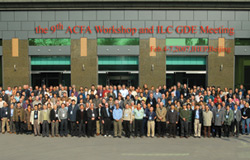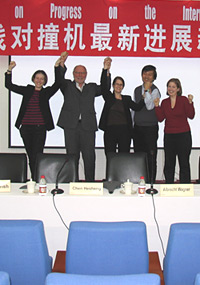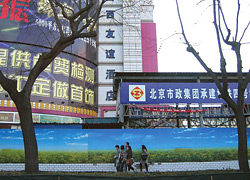 |
| Photo: Reidar Hahn, Fermilab |
Essay: Barry Barish
After extensive international collaboration and planning, the International Linear Collider has reached a milestone with its Reference Design Report. The reference design provides the first detailed technical snapshot of the next-generation machine.
The ILC’s reference design
Almost two and a half years ago, the international physics community made a mon-umental decision on how to build the International Linear Collider. Just recently at the 2007 Beijing ILC Workshop in February, the ILC celebrated its second major milestone, the release of the Reference Design Report. I find it interesting that the first and second major milestones for this global project occurred in the very same room in the very same place in the world at the Institute for High Energy Physics in Beijing, China.
 |
| Photo: IHEP, Beijing |
 |
| Members of the ILC communication team celebrating the release of the Reference Design Report. Pictured: Perrine Royole-Degieux, IN2P3 (France); Neil Calder, SLAC; Barbara Warmbein, DESY (Germany); Youhei Morita, KEK (Japan); Elizabeth Clements, Fermilab (USA) Photo: Maxine Hronek |
My last trip to China was actually ten years ago, and Beijing was a very different place then. A sea of bicycles has been replaced with cars, and the original hutongs are now surrounded by high-rise modern buildings. It is wonderful to witness such changes firsthand and see a nation progress much in the same way the effort to build a linear collider has progressed.
Within the last ten years, the ILC has evolved from an idea to a detailed design, produced by the Global Design Effort, a recognized international body that represents more than 1000 scientists and engineers who have dedicated their lives to making this dream come true. Every decision about the design for the machine has been made by this international body, something that I think is unique for science.
It has always been our plan to have every stage in the development of the machine conducted in an international manner. The recent publication of our Reference Design Report represents the true international cooperation that went into producing such a document that will guide us through the next engineering phase of the project.
The reference design provides the first detailed technical snapshot of the next-generation machine, defining in detail the technical parameters and components that make up each section of the accelerator. We succeeded in creating a design that can match the physics dreams and goals that have been outlined by the scientific community. As part of the reference design, we also produced a preliminary value estimate of the cost for the ILC in its present design and at the present level of engineering and industrialization. The estimate contains three elements:
- 1.8 billion ILC Units for site-dependent costs, such as the costs for tunneling in a specific region;
- 4.9 billion ILC Units for shared value of the high technology and conventional components; and
- 22 million person-hours = 13,000 person-years (assuming 1700 person-hours per person-year)
For this value estimate: 1 ILC Unit = 1 US Dollar (2007) = 0.83 Euro = 117 Yen
In arriving at an estimate, we used a value accounting process that has become standard for international scientific projects such as the ILC. Based on the detailed technical requirements of the machine, we determined the values of components based on a worldwide call for bids to obtain the required quality at the lowest reasonable cost. The estimate gives a first evaluation of the ILC at this time and will continue to evolve.
The value cost estimate will provide guidance for optimization of both the design and the R&D to be done during the engineering phase, which will start in the fall of 2007, after the final Reference Design Report will be completed. Based on what has been learned so far, we are confident that the value can be maintained at this level, as the design becomes more optimized during the next phase of the project. Many very talented physicists and engineers did a tremendous amount of dedicated work in producing the reference design. This is just one step along the way, and we hope to come back soon with our next accomplishment, maybe even in the same room in Beijing. Barry Barish |
||||||
Click here to download the pdf version of this article.





